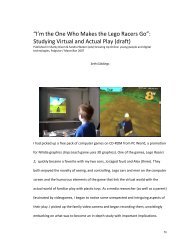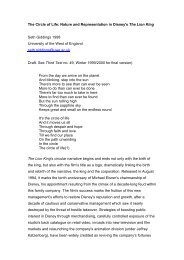Walkthrough: videogames and technocultural form - Seth Giddings
Walkthrough: videogames and technocultural form - Seth Giddings
Walkthrough: videogames and technocultural form - Seth Giddings
You also want an ePaper? Increase the reach of your titles
YUMPU automatically turns print PDFs into web optimized ePapers that Google loves.
future for the human body. Donna Haraway’s work is particularly influential here. For Haraway, ‘a cyborg is<br />
a cybernetic organism, a hybrid of machine <strong>and</strong> organism, a creature of social reality as well as a creature of<br />
fiction’ (Haraway 1990: 191). This ambiguous status is bound up with the cyborg’s descriptive <strong>and</strong> utopian<br />
possibilities for Haraway, <strong>and</strong> it is reflected in the diverse ways in which this figure has been discussed. For<br />
some it suggests that the posthuman is predicated on observations or warnings that the corporeal aspects of<br />
the human are, or will be, undergoing trans<strong>form</strong>ation. Others invoke the cyborg <strong>and</strong> the posthuman<br />
(following Latour for example) to argue that humans <strong>and</strong> human societies have always been technosocial <strong>and</strong><br />
hence never simply or exclusively ‘human’. Elsewhere these imagined <strong>and</strong> actual bodily changes are<br />
interrogated from a post-structuralist tradition for their implications for prevailing notions of subjectivity,<br />
i.e. it is humanism as a post-Enlightenment meta-discourse that is undergoing trans<strong>form</strong>ation (Badmington<br />
2000). This could be termed ‘critical posthumanism’. The work of Haraway is again central here. This latter<br />
posthumanism strikes a chord with Science <strong>and</strong> Technology Studies, for example in a special issue of the<br />
journal Cultural Critique in 2003, <strong>and</strong> in debates between, for instance, Haraway <strong>and</strong> Latour.<br />
The question of what kind of relationship between the human <strong>and</strong> the technological is brought into<br />
being in videogame play is the focus of Part 4.<br />
methodological questions<br />
1. this thesis will offer critiques of established Media <strong>and</strong> Film Studies models of textual analysis for<br />
<strong>videogames</strong> as interactive / cybernetic media, <strong>and</strong> propose instead cybertextual analysis<br />
2. it will draw on ethnographic approaches to media consumption <strong>and</strong> play, in particular small-scale studies.<br />
It will argue that the very small-scale <strong>and</strong> intimate circuit between player <strong>and</strong> game is a vital object of<br />
analysis.<br />
3. A synthesis is needed between these analytical <strong>and</strong> ethnographic methods given the project’s<br />
unwillingness to establish an a priori asymmetry between videogame (as ‘text’), videogameplay (as<br />
consumption or practice) <strong>and</strong> videogameplayer (embodied media subject). I call this synthetic approach<br />
microethnography. This microethnography will have to challenge the anthropocentrism of ethnography <strong>and</strong><br />
anthropology (the etymology of these terms roots them in the study of human society <strong>and</strong> ‘Man’) to attend to<br />
nonhuman as well as human agencies in play. Therefore cybercultural <strong>and</strong> STS concepts <strong>and</strong> approaches will<br />
19




